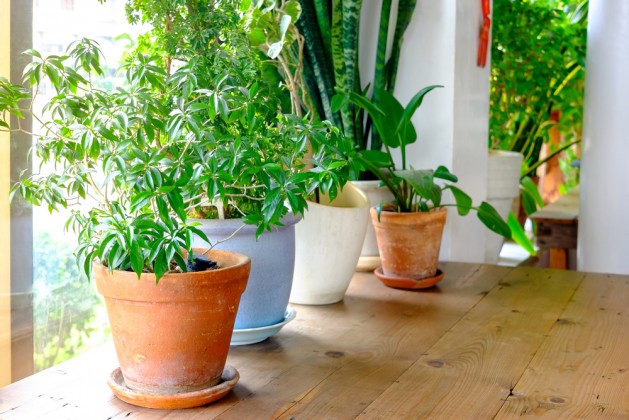
Did you know the air you’re breathing could be dangerous? Indoor air pollutants are everywhere and can cause serious issues, such as dizziness, headaches and nausea. Particularly in the winter, when all your windows are sealed, you also seal in the contaminants with you. The most common household pollutants are benzene, formaldehyde,and trichloroethylene. They are caused by pollen, mold, smoke, car exhaust, and improper ventilation. Some people choose to buy an air purifier, which can lessen the effects of asthma, allergies and secondhand smoke. However, there is a more cost-effective, all natural, and more beautiful alternative to cleaning your air. Houseplants! The houseplants absorb toxins when they convert carbon dioxide to oxygen, as well as the microorganisms that live in the soil of the plants. Simply having these pretty, healthy houseplants in your home can lower the air contaminants and protect your lungs, while only requiring sunshine and water. Not to mention, houseplants improve your mood, lower your blood pressure and relieve stress. Seems easy enough! Check out the following houseplants that you can include in your home and start breathing cleaner air today.
Here are our favorite houseplants.
Peace Lily (Spathiphyllum)
This plant absorbs all three pollutants, as well as others. It needs to be kept dust-free to clean the air most effectively. It can be kept in low or bright light, but the blooms thrive better in the brightness. It requires water daily and fertilizer monthly.
Gerbera Daisy (Gerbera jamesonii)
This plant removes benzene and trichloroethylene, and reaches its fullest potential in your laundry or bedroom (assuming it has access to lots of sunlight). In fact, it needs at least six hours of direct sunlight per day, as well as misting the leaves a few times a week. Be sure this pot has plenty of drainage holes, though. It prefers well-drained soil.
Ficus (Ficus benjamina)
A ficus will attack all three air pollutants, and is very low maintenance. It simply needs bright, indirect light and must be completely dried between waterings. Make sure the plant has plenty of room to grow, as a ficus can grow up to ten feet tall. Though an indoor plant, you can set the pot outside during the spring to enjoy the warm weather and bring it back in during the evenings.
Florist’s Chrysanthemum (Chrysanthemum morifolium)
More than fighting benzene and formaldehyde, a mum will also go after ammonia and xylene. Since it only lasts about six weeks, there is no reason to fertilize it (it won’t re-bloom). Therefore, the only maintenance needed is damp soil (water every other day or daily) and indirect sunlight. Choose a floral mum for indoors—garden variety mums are better suited for outside.
Azalea (Rhododendron simsii)
Best for combating formaldehyde, azaleas like cooler places, such as a basement. Around 60-65 degrees is their comfort zone, but they also like indirect sunlight. Mist the plant every couple days. It only needs fertilizer in late winter and early summer. To keep it healthy, remove dead leaves and blooms that fall into the soil (if left there, disease may spread).
English Ivy (Hedera helix)
Ivy is a climbing plant, and grows best in hanging baskets. As they require low-light, they can brighten up a dark spot in your home with their various shades of green. It fights the three common pollutants, as well as carbon monoxide and allergens, such as mold or animal dander. Water generously and keep moist, but be careful not to overwater. Provide fertilizer monthly.
Chinese Evergreen (Aglaonema crispum ‘deborah)
The longer it is exposed to your home, the more pollutants it will absorb! It will attack the common three, and also carbon monoxide. They thrive in low light and are really good plants for beginners, as they are easy to care for. The leaves come in variety of patterns. However, they are a tropical plant and prefer humid air, so misting the leaves will be necessary regularly. Water moderately and fertilize during the growing season. The evergreen will need to be repotted every 2-3 years.
Tips for caring for houseplants
- Choose one 10 to 12-inch potted plant per 100 square foot of your home for the most effective air purification.
- Periodically dust the leaves of each plant with a damp cloth to ensure proper absorption of air particles and toxins.
- Whenever possible, capture rainwater for your plants. All types of houseplants thrive best with natural sources of water.
- Because common names can vary, be sure to cross-reference the botanical name of any plant you get to ensure it will do the job you need it to do.



